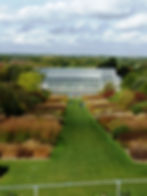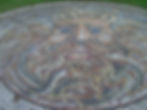Niwaki and Pruning Japanese-Style
This is the text and photos submitted for an article in the next issue of Professional Horticulture
Most gardeners are familiar with, and often in awe of, the ancient art of bonsai, the technique of pruning which allows trees to be kept, often for centuries, miniaturised, in ornamental ceramic containers. This pruning art form belongs to a class of highly refined techniques used in Japanese horticulture to shape plants for the creation dramatic garden effects.

Japanese gardens are designed to look natural, but are in fact cleverly fashioned ‘stage-sets’ with trees and shrubs carefully positioned, trained, shaped and pruned to give exactly the right atmosphere, vista or emotional impact from particular points in the garden. Gardens are deeply symbolic and constructed to create surprise, movement or stillness or to generate appreciation of the beauty of passing moments and seasons, in particular ‘mono no aware’ – by evoking a gentle sadness or pathos at the impermanence of things, as well as a more profound poignancy and awareness of the transience of life.

Trees play an important role in creating these tableaux and in rousing deep emotions, from the joyful profusion of cherry blossom in spring and the stunning, richly-coloured autumn maples (‘burning mountain in autumn’), to the melancholy winter silhouettes of pagoda trees and pines.
Unlike European formal, symmetric topiary, shaped trees in Japanese gardens appear more natural. They are very carefully pruned in asymmetric shapes to produce impressions of being windswept, gnarled and ancient, in order to help generate the visual effects that create transcendent feelings and thoughtful moods in the viewer.

Niwaki is the general term applied to this pruning technique, related to bonsai, as applied to trees in the ground rather than containers. Niwaki translates as ‘garden trees/plants’ or ‘sculpted trees’ to distinguish them from trees growing naturally in the wild, and is often applied to any pruned garden plant.

These long-established techniques are used to shape and form plants that look older, more weather-beaten and more interesting; to reveal a natural-looking and graceful tree that ‘expresses its own essence’, performs its mood-provoking role and fits well in its allotted space. They have to be controlled and miniaturised to stay in scale and harmony with their surroundings, and so have become popular in the west because they are ideal for the more restricted spaces of today’s urban environments. They well suit the contemporary ‘cool Zen’ minimalist architectural styles of the 21st Century.
The art of niwaki has been developed over centuries, by generations of Shinto and Buddhist monks, samurai and gardeners to become a highly-evolved and specialised art form deriving from the respect for nature and aesthetic appreciation and attention to detail that is at the heart of Japanese culture.

The craft involves careful selection of size, proportion, radial branch distribution, and spacing between branches, plus trunk-shaping, such as the popular S-shapes using weights and wires to sculpt pleasing forms. Other techniques include cascade branch-forming, candle-pruning, needle grooming and whorl pruning of pines.
This pruning craft and art was not just confined to trees. The art of karikomi refers to the different forms of clipped hedge or clipped shrubs common in Japanese gardens.

Bushes are planted close together and pruned so as make a single hedge or series of hedges to serve as either the compositional focus of garden, as a background or as a screen to block out an unwanted view. Semi-abstract shapes are created as ocean wave, layered cloud, mountain, fence and flat styles, depending on their location or function, or symbolic elements are created such as the crane island, tortoise island and treasure boat. Other styles include the later, better-known single clipped shrubs (tamamoto) especially using azaleas and often planted in association with rock groups.

Against this long-established background, British gardeners have recently started to become familiar with these stylised trees which have become more and more popular (despite extravagant price-tags) within the landscape trade; often called ‘cloud-pruned’ trees, or more disparagingly as ‘pom-pom’ or ‘poodle’ trees, these are the modern-trade equivalent plants based on the ancient art of niwaki. They vary in quality with some trees pruned to very high standards with others seemingly a parody of the art form.
Britain’s foremost authority on Japanese pruning techniques is Jake Hobson, a sculpture graduate from the Slade School of Art who won a travel award to study in Japan, where he got interested in their gardens, and how they link to the surrounding landscape. A month-long trip ‘to see the cherry blossom’ ended up as two years, including working at a traditional tree nursery in Osaka. It was here that he was introduced to the formative training and pruning of trees.

He has written the definitive text in English on the subject 'Niwaki: Pruning, Training and Shaping Trees the Japanese Way' followed by ‘The Art of Creative Pruning’ both published by Timber Press.
Anna Pavord, the distinguished garden writer says “His book is practical, in the sense that through photographs and drawings he explains the differences between the various styles of niwaki: bendy, twin-trunked, multi-layered, with branches set out in alternating steps or with foliage clipped into shell-like domes. Succeeding chapters deal with the most important plants used for niwaki in Japan and show how to train them.”
Finding it difficult to get the results he wanted by using traditional English tools Jake has introduced many of the gardening cognoscenti to, not only the art of niwaki, but also to a whole world of Japanese pruning tools and equipment which are now for sale on his website http://www.niwaki.com/
Jake says “I worked at Architectural Plants in Sussex, where my creative enthusiasm was harnessed by Angus White, introducing Japanese attitudes to pruning and maintenance. During this time I realised how much better the tools I had used in Japan were to those on offer in England, so with the help of brother-in-law Haruyasu (a gardener in Osaka) the very first Japanese tripod ladders and secateurs were shipped over. People began to notice and soon a business grew: Niwaki.”
There is an amazing array of must-have pruning tools on offer on the website, including Tobisho and Okatsune secateurs and snips which are of samurai sword steel quality!

The Tripod ladders are fast becoming an industry standard for topiary work and hedge-pruning.
Many nurseries are now specialising in niwaki-style trees, including Architectural Plants, Crown Topiary, Paramount Plants, Heron’s Bonsai, etc specialising in fully shaped specimens.

Suitable plants include Buxus, Taxus, Pinus thunbergii, Pinus densiflora, Juniperus chinensis, and Ilex crenata, though there does not yet appear to be a strong market for shaped maples, perhaps due to the considerable expense of production.
Jake Hobson’s books encourage gardeners to try this style of pruning for themselves, giving simple, clear instructions on starting pruning and shaping trees from scratch, but he also gives practical demonstrations, workshops and lectures on the subject throughout the year.
To keep mature plants looking good niwaki maintenance pruning is usually carried out annually with secateurs or shears in early or late summer, although faster-growing species such as Japanese privet may need to be trimmed more often.

Timing needs to take into account of flowering times where necessary to avoid pruning forming flower buds.
Plants with larger leaves are better hand-pruned with secateurs to avoid unattractive part-cut or damaged leaves, which are more visible on larger leaved plants.
This Japanese style of miniaturising trees is ideally suited to smaller European urban gardens, especially patio areas and terraces around houses. Their striking shapes and visual effects are in keeping with contemporary style and could well become even more fashionable in the future, especially if arboriculturists and horticulturists get trained and offer this as a standard service in future!


























